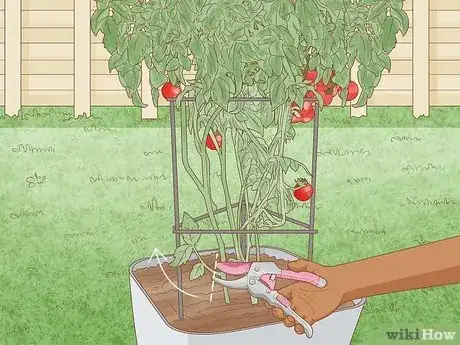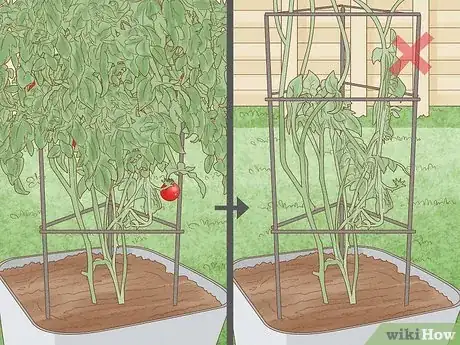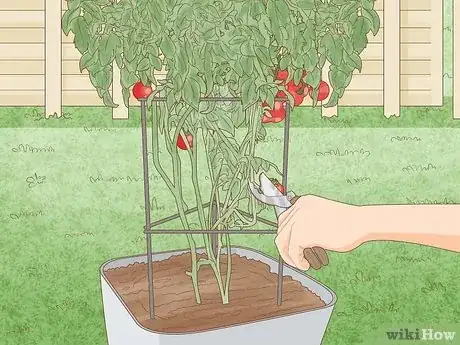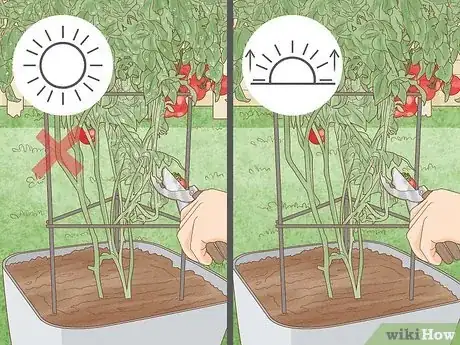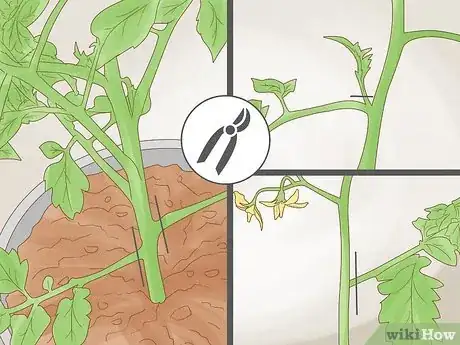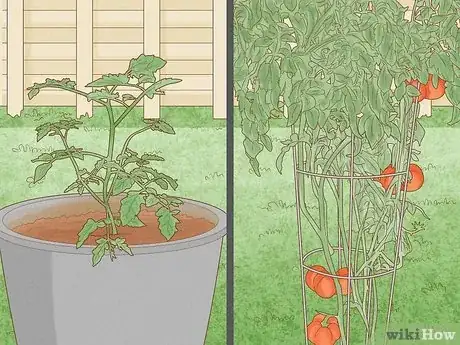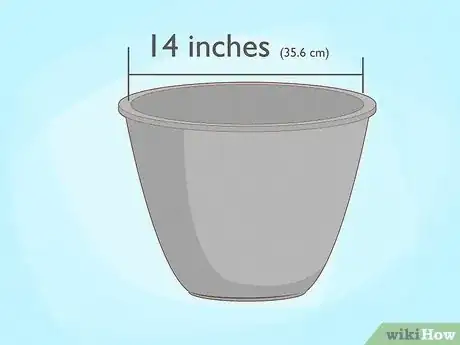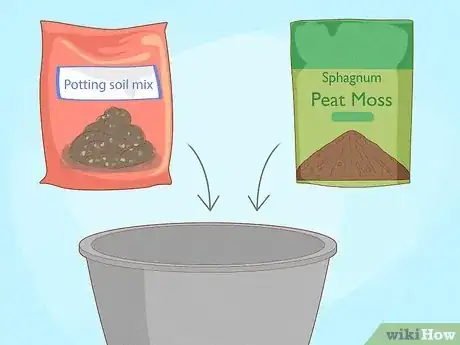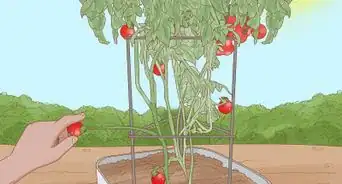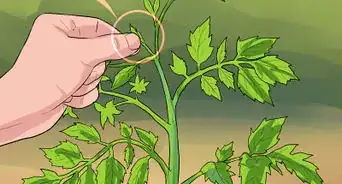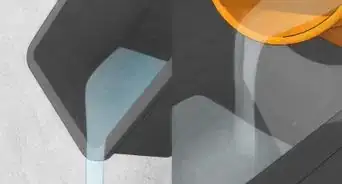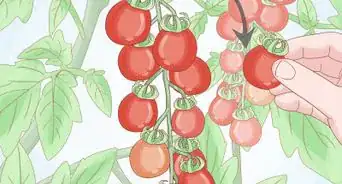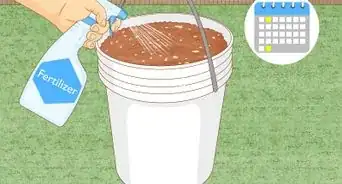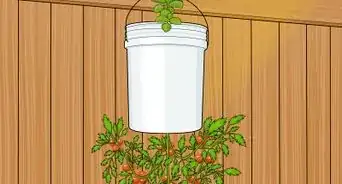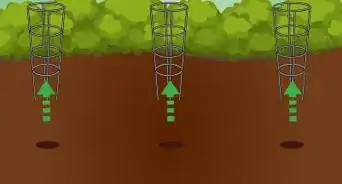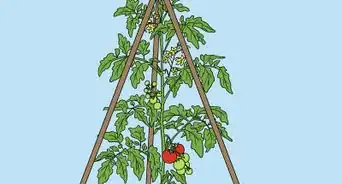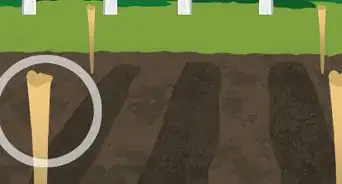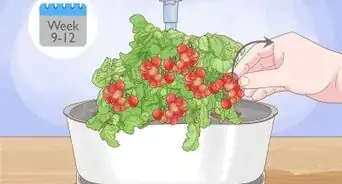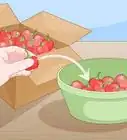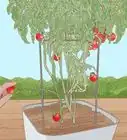This article was co-authored by Katie Gohmann. Katherine Gohmann is a Professional Gardener in Texas. She has been a home gardener and professional gardener since 2008.
wikiHow marks an article as reader-approved once it receives enough positive feedback. In this case, 100% of readers who voted found the article helpful, earning it our reader-approved status.
This article has been viewed 96,650 times.
Growing tomatoes on your patio can be a fun and tasty hobby. Most tomato plants will grow quite easily and shouldn't require much maintenance over their life. However, some people find that pruning their tomato plants can help keep the plant healthy and result in more tomatoes. The pruning process itself is simple and won't require any special tools to get started.
Steps
Pruning Your Tomato Plant
-
1Start at the bottom of the plant. It can be helpful to start pruning your tomato plant from the bottom and working your way up. This will allow you to keep track of your progress and you'll be able to clearly see what needs to be removed as you work. Carefully work your way up the plant, pruning any non-essential growth away from it.[1]
- Most of the pruning will take place at the bottom of the plant.
- Newly formed stems will need to be removed. These stems take nutrients away from your tomato fruits.
- Many stems on the lower portion of the plant will not yield fruit.
-
2Remove unwanted stems and leaves. Most tomato pruning can be done by pinching off whatever part of the plant needs to be removed. Hold the part of the plant between your thumb and index finger before gently snapping the piece away. You may need to move the piece back and forth until it loosens enough to break off.[2] [3]
- Most sections of the plant should be easily pinched off.
- Pruning shears are not needed unless a piece is too big to break away by hand.
- Using pruning shears can open the plant up to possible infection.
- If you must cut something from your plant, it's best to use a razor blade.
Advertisement -
3Don't overdo the pruning. It's important that you leave enough leaves and stems for the plant to function properly. Cutting away too much of the plant can cause it to grow slowly or possibly die. Removing too many leaves can expose the fruit to the sun and ruin the tomatoes. If you are in doubt about pruning something, it's best to leave it on.[4]
- It can be a good idea to leave at least one stem on each time you prune. These stems can eventually produce extra tomatoes.
- You'll want around 4 or 5 stems on your plant that are producing fruit.
- If tomatoes would be exposed to the sun, it's best to leave stems and leaves on that area to provide shade.
- Don't remove more than 1/3 of the total plant while pruning.
Learning When and How to Prune Your Tomatoes
-
1Prune your plants once a week. Pruning your tomatoes will be an ongoing process. New growth will constantly be underway and you'll want to direct that growth to produce the most tomatoes. Keep up with your pruning by removing unwanted growth around once a week.[5]
- Pruning too often might remove more of the plant than is necessary.
- Leaving your plant without pruning could allow for unnecessary growth to occur.
- Harvesting tomatoes often can result in greater yields throughout the life of the plant.[6]
-
2Prune your plants under the best conditions. There are two main things that will help your tomato pruning efforts: the time of day and the weather. It's recommended that you prune in the mornings, as unwanted stems will break away easier. It's also important that you prune when the plant is dry to prevent any diseases from affecting your tomato plant.[7] [8]
-
3Know which parts of the plant to prune. The goal in pruning your tomato plant will be to remove any non-essential foliage or growth. To do this, you will need to know which parts of the plant can be removed and which parts need to remain intact. When pruning your tomato plant, focus on removing these extra parts to help increase the amount of tomatoes produced:[9]
- Most lower branches can be cut away from the plant.
- Cut away any new stems that are starting to grow from old ones.
- Any stems that don't have either flower or fruit can be removed.
- Snap off any dead or discolored leaves.
-
4Consider cutting off the main growth. It's common for tomato plants to grow upwards instead of of outwards. If your tomato plant has grown too high, you may consider pruning the topmost growth stems. This will prevent the plant from growing upwards, redirecting growth outwards to the tomatoes themselves.[10] [11]
- Cutting off the top of the plant will prevent all upwards growth. It's a good idea to only do this late in the growing season, before the first frost.
- Without the top stem in place, your tomato plant will focus growth into the fruit instead of the stems or leaves.
Starting Your Tomatoes
-
1Learn the two main types of tomato plants. If you are going to grow tomatoes on your patio, you will need to make sure they are the variety you want. There are two main varieties of tomatoes plants: determinate and indeterminate. Determinate tomato plants will grow in a small bush and are generally well suited to planting in a container. Indeterminate tomato plants will grow larger than determinate tomatoes, but can be more challenging to grow in a container.[12]
- Determinate tomatoes are usually the best type of tomatoes to grow on your patio.
- Determinate tomato plants will likely not need to be pruned.
- Indeterminate tomatoes will usually require a wire or wooden stake to grow properly.
- Indeterminate tomato plants can benefit from pruning.
-
2Get the right size container. Your tomato plant will need enough room to grow into. If the container is too small for your plant, it may have difficulty reaching maturity and producing tomatoes. Think about how many tomato plants you want to grow on your patio and select the right size containers for them. Keep in mind that tomato plants can get quite large, too.[13]
- The exact amount of room required may vary between types of tomato plants. Always check the recommended space requirements for your tomato plant when considering a container. As a rule, though, each tomato plant will need a pot of at least 14 inches (35.6 cm) in diameter.
- Most single plant containers will accommodate one tomato plant.
- Smaller planters will generally result in smaller tomato plants.
- You can plant multiple tomato plants in one container. However, you will need to make sure each plant has enough room to grow.
- Larger containers can allow the plant to grow more and may hold more water in the soil.
-
3Provide the best soil. Not all soil will be ideal for your tomato plant. You'll want to provide the right type of soil for your plant to help it grow quickly and fully. Having the proper soil can also have an effect on the quality of the tomatoes that the plant produces. Keep some of these tips in mind when looking for the best soil for your tomato plants:[14] [15]
- Use only high-quality potting soil mixtures when adding soil to your container. Your plants get nutrients from the soil you provide, so the better the soil, the more your tomatoes will thrive.
- Adding in compost can give your plants extra nutrients.
- Peat moss can be a good addition to your soil mix.
- Avoid using dirt or soil from your yard, as it may not contain the necessary nutrients or composition.
Community Q&A
-
QuestionHow often and how much water do tomatoes need?
 Community AnswerUnfortunately, there's no easy answer to this question. It depends on what your climate is like and how much sun your plants are get. In my area, tomato plants might need up to a gallon of water per day in the peak of summer, but that would be too much in a place where the heat only reaches 75 degrees. Tomatoes don't like to dry out but they also don't like to stay wet. They can get wilt diseases easily when the soil is too damp. That said, you'll have to experiment. Start by making sure your pot is large enough, because a small pot will dry out too soon. Give your plant a good soak in the morning and check it the next day. If the soil still feels damp, leave the plant alone. Don't water again until the soil is dried out 3" below the surface. Continue this cycle until you get a good feel for how long it takes your plant to absorb water. Good luck!
Community AnswerUnfortunately, there's no easy answer to this question. It depends on what your climate is like and how much sun your plants are get. In my area, tomato plants might need up to a gallon of water per day in the peak of summer, but that would be too much in a place where the heat only reaches 75 degrees. Tomatoes don't like to dry out but they also don't like to stay wet. They can get wilt diseases easily when the soil is too damp. That said, you'll have to experiment. Start by making sure your pot is large enough, because a small pot will dry out too soon. Give your plant a good soak in the morning and check it the next day. If the soil still feels damp, leave the plant alone. Don't water again until the soil is dried out 3" below the surface. Continue this cycle until you get a good feel for how long it takes your plant to absorb water. Good luck!
References
- ↑ http://www.slideshare.net/SaferBrand/how-to-prune-tomato-plants-the-right-way
- ↑ http://www.slideshare.net/SaferBrand/how-to-prune-tomato-plants-the-right-way
- ↑ https://www.youtube.com/watch?v=_dDedxmI7uw
- ↑ http://www.slideshare.net/SaferBrand/how-to-prune-tomato-plants-the-right-way
- ↑ http://www.slideshare.net/SaferBrand/how-to-prune-tomato-plants-the-right-way
- ↑ http://www.gardeningchannel.com/quick-tips-for-container-tomatoes/
- ↑ https://www.youtube.com/watch?v=_dDedxmI7uw
- ↑ http://www.slideshare.net/SaferBrand/how-to-prune-tomato-plants-the-right-way
- ↑ http://www.slideshare.net/SaferBrand/how-to-prune-tomato-plants-the-right-way
- ↑ http://www.slideshare.net/SaferBrand/how-to-prune-tomato-plants-the-right-way
- ↑ https://www.youtube.com/watch?v=_dDedxmI7uw
- ↑ http://www.conservationinstitute.org/growing-tomatoes-in-pots-heres-what-you-need-to-know/
- ↑ http://www.conservationinstitute.org/growing-tomatoes-in-pots-heres-what-you-need-to-know/
- ↑ http://www.conservationinstitute.org/growing-tomatoes-in-pots-heres-what-you-need-to-know/
- ↑ http://www.finegardening.com/potting-soil-ingredients
- Videos provided by Tower Garden
About This Article
Pruning your patio tomatoes can help to keep the plant healthy and prevent it from getting overgrown. About once a week, you’ll want to remove any dead or discolored leaves, new stems that are growing from old ones, and stems that don’t have fruit or flowers. If the plant’s growing too high, you can also prune the top stems. However, don’t remove more than a third of the plant at a time. It’s best to prune your plant in the morning when the stems will be easier to break. You should be able to snap the leaves and stems off with your fingers, but if they’re too tough, use a razor blade to cut the stems. Don’t use shears, since this can leave your plant vulnerable to infection. For more tips from our Gardening co-author, including how to pot your tomato plant, read on!
